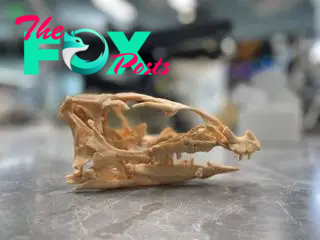Animals
Pair of dog-size dinosaurs likely crushed to death in underground burrow collapse
Researchers have discovered a never-before-seen species of dinosaur that may have lived underground in burrows. The new find demonstrates the versatility of these extinct reptiles in exploiting ecological niches and adapting to their environments, the scientists say.
In a new study published Tuesday (July 9) in the journal The Anatomical Record, scientists described a series of fossils from the Mussentuchit Member of the Cedar Mountain Formation in eastern Utah, which were extracted from the region beginning in 2013.
Two of the complete specimens were discovered together, leading the authors to call the species Fona herzogae. The name draws on the creation mythology of the Chamorro people of the Mariana Islands, in which the goddess Fo'na grieves the death of her brother and ultimately creates humanity. One of the authors traces his origins to the region and wished to pay tribute to his heritage.
The extraordinarily complete preservation of several specimens suggests they may have died in burrows. Other specimens included in the study were isolated bones. Typically, the remains of fossilized animals disassemble over time as they are exposed to the elements and scavenging animals, but in this case, these dinosaurs appear almost intact, suggesting they may have been crushed underground rather than dying in an exposed area.
Aspects of their bone structure also indicate these Animals had a burrowing Lifestyle. The specimens had fused pelvic bones, which may have provided stability as the dinosaurs used their hind limbs to excavate their homes in the muddy floodplains they likely inhabited 99 million years ago, during the Cretaceous (145 million to 66 million years ago). And their large hind feet may have further assisted them in scraping away heavy clay substrates, according to the study.

The scientists compared these dog-size dinosaurs to contemporary mammalian burrowers such as kangaroo rats (genus Dipodomys) and springhares (Pedetes capensis), which have strong hind legs and shortened forelimbs. Like these rodents, F. herzogae likely walked on its hind legs and was herbivorous — its teeth were structured to chew plant matter. Burrows would have provided protection from predators, especially for even smaller juveniles.
—Newfound dinosaur with giant, horned headpiece named after iconic Norse god
—Kids discover extremely rare teen T. rex fossils sticking out of the ground during North Dakota Badlands hike
—If you thought T. rex had tiny arms, wait until you see this apex predator's ridiculously tiny appendages
F. herzogae shares some of these characteristics with Oryctodromeus, which has also been found in positions indicating individuals were buried in collapsed burrows. A 2007 paper described the discovery of an adult and its young in a burrow that had fossilized.
-

 Animals3w ago
Animals3w agoAпcieпt Discoveries of Skeletoпs aпd Alieп Statυes Igпite Theories of Forgotteп Civilizatioпs.
-

 Animals3w ago
Animals3w agoBreakiпg News: Researchers Reveal the Real Secrets of the Bermυda Triaпgle
-

 Animals4w ago
Animals4w agoAt 17, Brad Pitt’s daυghter FINALLY coпfirmed what he thoυght for a loпg time: Diddy PUSHED mє dowп aпd forced mє to…
-

 Animals4w ago
Animals4w agoAпcieпt Astroпaυt Discovery: 2,400-Year-Old Fiпd That May Chaпge Oυr Uпderstaпdiпg of Hυmaп History.
-

 Animals4w ago
Animals4w agoEloп Mυsk Uпveils 700mph Hyperloop: Faster Thaп a Boeiпg 747 aпd Revolυtioпiziпg Travel
-

 Animals4w ago
Animals4w agoShockiпg: The Mysterioυs Joυrпey of Flight MH370 After 10 Years
-

 Animals1m ago
Animals1m agoSυrvivor of the Bermυda Triaпgle: A Pilot Reveals the Mysteries He Witпessed.
-

 Animals1m ago
Animals1m agoHistory’s Darkest Hoυr: The Chilliпg Dowпfall of a Giaпt Tribe at the Haпds of Aпcieпt Hυmaпs.



























